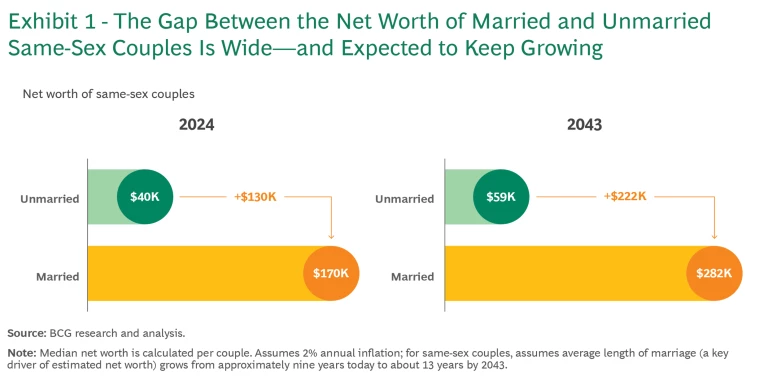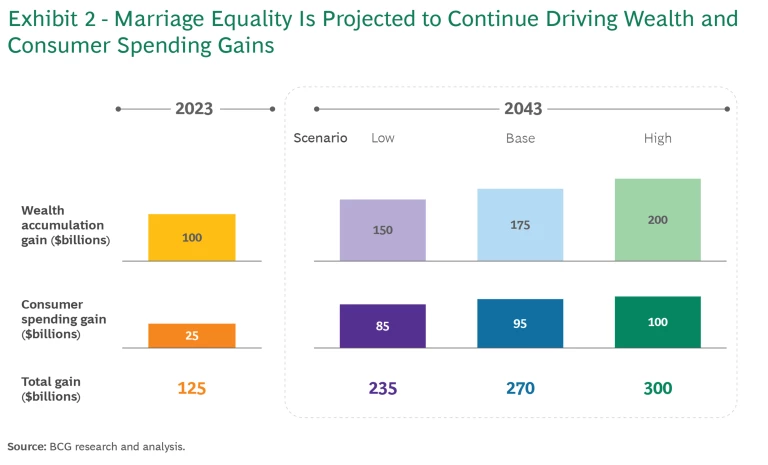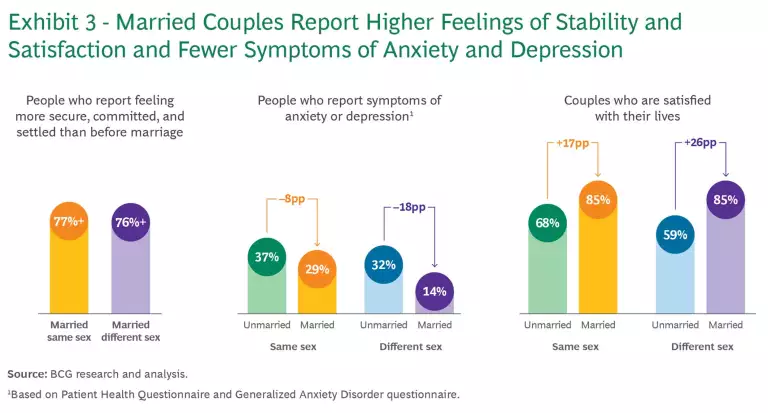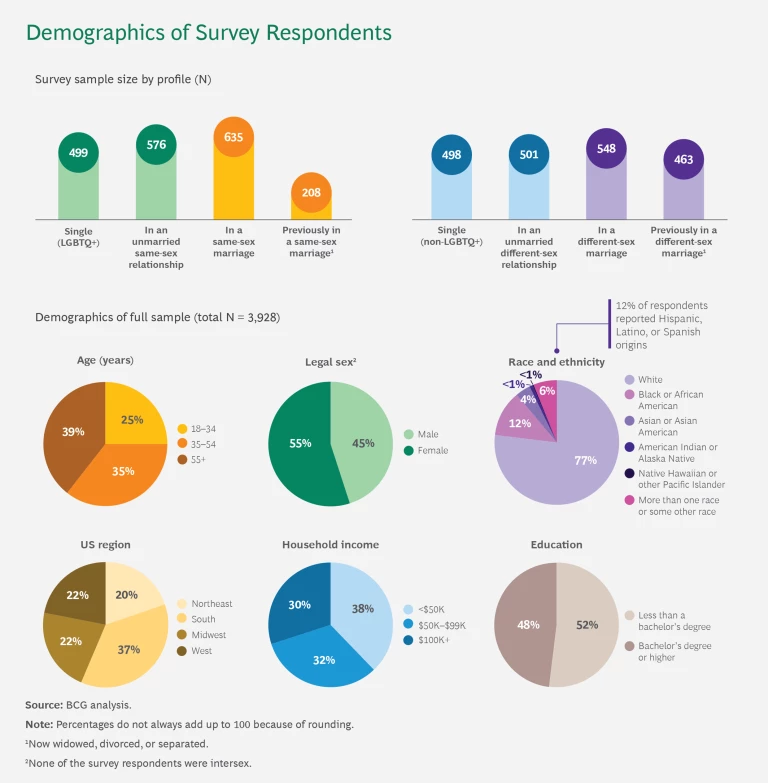Just over 20 years ago, Massachusetts became the first state to grant same-sex couples the right to marry. Many other states followed suit in the subsequent years. In 2015, the Supreme Court ruled in Obergefell v. Hodges that same-sex couples have the right to marry nationwide.
The positive financial impact of marriage on different-sex couples in the US is well-documented. People who are married have higher household income and net worth and spend more than those who are
There has been little research, however, into the effects of marriage for same-sex couples or its potential impact in the decades ahead.
A new study from BCG seeks to fill that gap. In March 2024, BCG surveyed nearly 4,000 people in the US on the topic of marriage equality. We captured responses from a socioeconomically, racially, and geographically diverse cross-section of married and unmarried same-sex and different-sex couples. (See “About Our Survey.”)
About Our Survey
Economic impact was quantified by comparing median net worth and annual expenditures between married and unmarried same-sex couples. Findings at the household level were validated, controlling for demographic variables including age, education, and household income. We adjusted for annual inflation. The annual expenditure estimate was controlled for household income. Data sources to estimate the projected growth in same-sex married households included US Census Bureau and Gallup surveys and polls.
While further research is needed to explore causality, our findings suggest that—as in the case of married different-sex couples—there’s a strong correlation between marriage for same-sex couples and favorable financial outcomes. Our analysis suggests these benefits will continue growing, as will their favorable impacts on the US at large:
- Married same-sex couples will accumulate over $130,000 more in net worth during the course of their marriage than unmarried same-sex couples.
- Married same-sex couples reported spending nearly $4,000 more each year than those who aren’t married.
- The boost to the US economy from same-sex marriage is about $125 billion to date, and we project it to lead to a $400 billion injection through 2043.
The Financial Benefits of Marriage Run Deep
Same-sex married couples reported a median household net worth that is approximately $130,000 higher than that of their unmarried same-sex counterparts, and this pattern of greater net worth seemed to emerge across different household income categories.
The difference in median net worth between married and unmarried different-sex couples is even greater (more than $355,000). That gap is likely a result of the fact that marriage for same-sex couples has been available for only a short period, and marriage length is a key driver of net worth for all couples.

Accordingly, over time as same-sex couples are married for longer periods, they are expected to gain even more financial benefits. We project that by 2043, the difference in net worth between married and unmarried same-sex couples could grow to more than $200,000. (See Exhibit 1.)
Our research also found that being in a long and committed relationship is still not as financially beneficial as being married. For example, same-sex married couples who have been together for at least ten years, no matter the length of their marriage, build over $150,000 more in median net worth than unmarried same-sex couples who have been together for over ten years.
A large part of what is driving the differential between married and unmarried couples is the more than 1,000 federal and state laws in the US that reward marriage, providing benefits, protections, and overall advantages for married couples and their families. These include:
- Federal tax advantages, including the potential ability to file jointly and enter a lower tax bracket as well as the benefit of pooling deductions
- Social security and survivor benefits, ensuring a widow or widower has financial support
- Health-care-related provisions, such as spousal coverage in many employer-sponsored health insurance plans and job-protected medical leave to care for a sick spouse
- Access to family-based immigration, including the ability to sponsor a spouse for a green card and a faster path to obtaining US citizenship
In addition, married couples, whether same-sex or not, are likelier to have higher household income. That income can promote acquisition of greater assets, such as more home equity, retirement savings, and stocks and mutual funds. (Of course, there are two components of wealth—that which people build over time and that which they inherit. We’re only accounting for the first in this work.)
Asset acquisition—and more broadly, boosting familial wealth across the board—has been shown to improve family stability and well-being across income groups, while also promoting macroeconomic growth for the
Further, our research revealed details about the discretionary spending habits of married and unmarried
A Ripple Effect on the US Economy
The impact of marriage for same-sex couples on the US economy will likely grow over time as more people identify as LGBTQ+, the average length of marriage increases, and public acceptance of same-sex marriage continues to
In 2022, according to the latest US Census Bureau data, there were about 741,000 same-sex married households, representing 1.2% of all marriages. Millennials and Gen Zers are more likely to identify as LGBTQ+ than members of older generations. If current trends continue, and assuming divorce rates remain constant, BCG projects there will be around 1.2 million same-sex married couple households in the US by 2043—or 1.9% of the total married population. (See “Same-Sex Marriage Projections.”)
Same-Sex Marriage Projections
As our base scenario, we estimated 1.2 million same-sex marriages by 2043, assuming about 5% of unmarried same-sex couples each year will marry the following year (based on estimated rates of 5% to 7% over the past five years).
This would translate to approximately $100 billion in wealth accumulation for same-sex couples who are married today and an additional $150 billion to $200 billion by 2043.
Based on our survey’s respondents, the current average length of marriage among same-sex couples—many of whom could not marry prior to 2015—is about nine years. According to our estimates, that average will be closer to 13 years by 2043. Because marriage length is a driver of net worth, that shift would render our net worth numbers conservative, including the projected $200,000 difference in net worth between married and unmarried same-sex couples.
Additionally, as explored above, the personal financial benefits of marriage have a positive impact on the US economy through consumer spending. Married same-sex couples have contributed about $25 billion to the economy to date and are projected to spend $85 billion to $100 billion more by 2043. (See Exhibit 2.)

In other words, the projected economic outcomes are likely to benefit US businesses and institutions, as well as all Americans—regardless of their marital status or sexual orientation.
The Benefits Go Beyond Money
Previous studies have shown that the nonfinancial impact of marriage on different-sex couples is powerful, with married people reporting greater satisfaction in their lives and better mental
Our findings broaden that understanding, revealing that marriage improves feelings of stability for all married couples, with approximately three-quarters of married same-sex and different-sex couples reporting they felt more secure, committed, and settled than they did before marriage.
Self-reported symptoms of anxiety and depression also improved after marriage for both groups. And those married to a person of the same sex reported higher life satisfaction (+17 percentage points) and lower incidence of anxiety and depression symptoms (-8 percentage points) than those in unmarried relationships. (See Exhibit 3.)

Married couples are also more likely to feel safe, accepted, and supported across their communities than unmarried couples—22% more in the case of same-sex couples and 24% among different-sex couples. This greater sense of stability and well-being could put them in a more comfortable position to make major (and often stressful) decisions about their financial future, such as buying a house and investing in retirement funds.
Overall, the findings suggest that marriage does indeed have benefits for those who choose it. (See “Methodology for Overall Analysis and Economic Calculations.”) These findings are consistent with research published by RAND in May of 2024, further cementing the notion that marriage equality adds to positive financial and well-being outcomes both for the individuals and for society more
Methodology for Overall Analysis and Economic Calculations
We incorporated a mix of quantitative and qualitative questions in the survey, covering topics such as household net worth, annual consumer spending, household income, perceived stability, life satisfaction, mental health, and social acceptance. Additional questions addressed respondents’ views on marriage equality.
Conducted online over three weeks, the survey included eligibility screening and informed consent procedures. To maximize response rates, we sent follow-up reminders and offered incentives to participants.
We cleaned raw data to remove incomplete responses and outliers. Data validation checks were performed to ensure consistency and accuracy. We calculated descriptive statistics to summarize the demographic characteristics of the sample and key survey variables. Measures included means, medians, frequencies, and percentages.
Population Sizing Analysis
We based projections of growth of the LGBTQ+ population on historical trends and national survey data. It is estimated that the LGBTQ+ population will grow from 8% of US adults in 2023 to 14% by 2043, driven by younger generations increasingly identifying as LGBTQ+.
Projections for the number of same-sex marriages were modeled using the current number of same-sex married households, projected growth in LGBTQ+ identification, and future marriage rates among LGBTQ+ individuals.
Economic Impact Analysis
The analysis estimated the additional wealth accumulation for same-sex married couples compared to their unmarried counterparts. Key factors included median household net worth, growth rates, and length of marriage. Projections were made for wealth accumulation from 2004 to 2043.
We also analyzed annual consumer spending differences between married and unmarried same-sex couples. The additional spending attributable to marriage was projected, considering current and future scenarios up to 2043.
Our research shows that same-sex couples choose marriage for the same core reasons as their opposite-sex counterparts: to express love and make a commitment. When making that choice became legal in the US—first in Massachusetts and eventually across the country—economic impact was not the main focal point.
But the financial benefits—and improvements to well-being—have been powerful, both for the couples themselves and the country as whole, contributions we expect will continue to grow in the decades to come.
The authors would like to thank Meg Cleary and Emily Looney for their support in conducting the research and analysis; the BCG SurveyOps team for its support with data analytics; Nathaniel Nelson and Colin Campbell for their support in developing the report; and Cole Barry, Joe Davis, Mario Farsky, Brian Gross, Gerry Hansell, Matt Krentz, Rich Lesser, Sharon Marcil, Alicia Pittman, Ulrike Runer-Schwarz, Michelle Russell, Nic Sukitsch, Elliot Vaughn, and Nadjia Yousif for their input and guidance.







